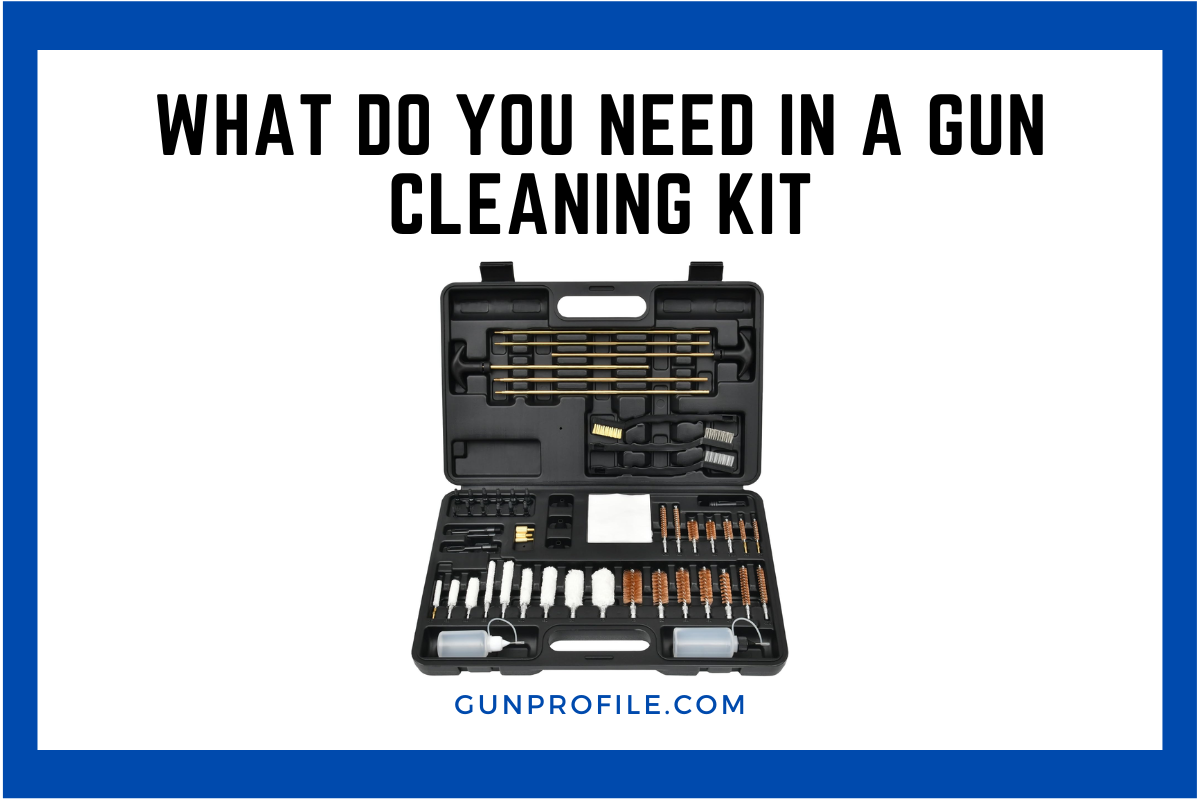Keeping your firearms clean is crucial for their performance and longevity. A good gun cleaning kit has all the tools you need to maintain your weapons properly. A basic gun cleaning kit should include cleaning rods, bore brushes, cleaning patches, solvents, and lubricants.
Different guns may need specific tools, so it’s smart to pick a kit that fits your firearms. Universal cleaning kits can work for many types of guns, but some people prefer kits made for certain calibers. The right kit helps you clean your gun safely and well.
Regular cleaning keeps your gun working right and lasting longer. It’s a key part of being a responsible gun owner. With the right tools, you can keep your firearms in top shape for years to come.
Key Takeaways
- Gun cleaning kits need basic tools like rods, brushes, and solvents
- Choose a kit that matches your specific firearms
- Regular cleaning is important for gun safety and performance
Essential Components of a Gun Cleaning Kit
A well-stocked gun cleaning kit contains several key items to keep firearms in top condition. These components work together to remove buildup, protect metal surfaces, and maintain proper function.
Cleaning Rod and Attachments
A cleaning rod is the backbone of any kit. It comes in different lengths and materials like carbon fiber or stainless steel. Choose one that fits your gun’s barrel length.
Attachments connect to the rod:
- Jags: Hold patches for scrubbing
- Loops: Secure patches for wiping
- Mops: Apply oil or solvent
Make sure to get the right size for your gun’s caliber. A universal kit with interchangeable tips works for multiple firearms.
Brushes and Bore Snakes
Brushes scrub away fouling in the barrel and action. Common types include:
- Bronze: For general cleaning
- Nylon: Gentler on surfaces
- Stainless steel: For tough carbon buildup
Bore snakes offer quick cleaning. They have a weighted cord with bristles that pulls through the barrel. One pass can remove light fouling.
For thorough cleaning, use brushes first, then a bore snake to finish.
Cleaning Solvents and Lubricants
Solvents break down residue from firing. Choose based on your gun’s needs:
- Copper removers
- Carbon cleaners
- All-purpose formulas
Lubricants reduce friction and protect against rust. Options include:
- Gun oils
- Greases
- Dry lubricants
Apply solvents with patches or brushes. Use lubricants sparingly on moving parts and metal surfaces after cleaning.
Patches and Patch Holders
Patches absorb solvents and wipe away debris. Cotton is common, but synthetic options are available. Keep various sizes on hand for different gun parts.
Patch holders or jags secure patches to the cleaning rod. They come in different shapes:
- Slotted: Hold patches firmly
- Pointed: Push patches through tight spaces
Use fresh patches until they come out clean. This ensures all fouling is removed from the barrel and other surfaces.
Specialized Tools and Accessories
Gun cleaning kits often include tools designed for specific tasks. These items help reach tight spots and handle delicate parts. They make cleaning more thorough and efficient.
Utility Brushes and Picks
Utility brushes and picks are key for detailed cleaning. Small brushes help scrub hard-to-reach areas. They remove dirt from tight corners and grooves.
Picks are great for precision work. They can dislodge stubborn debris from small spaces. Metal picks work well for tough buildup. Plastic ones are gentler on gun finishes.
A set with different sizes and shapes is best. This lets you tackle various cleaning needs. Look for brushes with both nylon and metal bristles. They offer different cleaning strengths.
Cotton Swabs and Microfiber Cloths
Cotton swabs and microfiber cloths are simple but vital tools. Swabs clean small parts and tight spots. They’re perfect for applying oil or solvent in precise amounts.
Microfiber cloths are lint-free and absorbent. They wipe away dirt and excess oil without scratching. These cloths can polish gun surfaces to a nice shine.
Use fresh swabs and clean cloths each time. This prevents spreading dirt or old oil. Keep a good supply on hand. They’re inexpensive and make cleaning easier.
Both items are lightweight and take up little space. This makes them ideal for portable cleaning kits. Always have some ready when you clean your gun.
Choosing the Right Kit for Your Firearm
Picking a suitable gun cleaning kit depends on your firearm’s caliber and your maintenance needs. Key factors include compatibility with different calibers and the quality of the included tools and materials.
Compatibility with Calibers
Gun cleaning kits come in various sizes to fit specific calibers. Some kits are designed for a single caliber, while others offer versatility for multiple firearms.
For handgun owners, a 9mm cleaning kit can cover many popular pistols. Rifle enthusiasts may need kits for .22, .30, or larger calibers.
Universal kits provide flexibility but may lack specialized tools for certain firearms. Consider your current and future gun collection when choosing a kit.
Multi-caliber kits often include interchangeable bore brushes and jags. This allows for thorough cleaning of different barrel sizes without buying separate kits.
Quality and Durability Considerations
High-quality cleaning kits use durable materials that withstand repeated use. Look for brass or nylon brushes, as they clean effectively without damaging the barrel.
Sturdy cleaning rods prevent bending or breaking during use. Some kits feature memory-flex cables instead of rigid rods, offering better maneuverability in tight spaces.
Storage cases protect tools and keep components organized. Water-resistant or MOLLE compatible cases are ideal for outdoor use or travel.
Check for additional features like bore snakes, cleaning picks, and CLP (cleaner, lubricant, protectant) solutions. These extras enhance the kit’s versatility and effectiveness.
Safe and Effective Cleaning Practices
Cleaning a gun safely and effectively requires careful attention to detail and following proper procedures. Using the right techniques helps maintain your firearm’s performance and longevity while ensuring safety.
Disassembling the Firearm
Start by making sure the gun is unloaded. Remove the magazine and check the chamber. Follow your gun’s manual for step-by-step disassembly instructions. Don’t force any parts.
Lay out the components on a clean, flat surface. Use a gun cleaning mat to protect both the gun and work area. Keep small parts in a container to avoid losing them.
Pay attention to how each piece fits together. Take photos or notes if needed for reassembly. Some guns have complex mechanisms, so be patient and careful.
Clean one part at a time to stay organized. Handle springs and other small components with care. If unsure about any step, consult the manual or a professional gunsmith.
Proper Use of Cleaning Agents
Choose the right cleaning products for your gun type. Use solvents designed for firearms, not household cleaners. Apply bore cleaner to remove fouling and residue from the barrel.
Use gun oil sparingly on moving parts to reduce friction. Too much oil can attract dirt and affect performance. Avoid getting oil on ammunition or in the firing pin channel.
Wear gloves to protect your skin from harsh chemicals. Work in a well-ventilated area to avoid breathing in fumes. Keep cleaning agents away from food and drinks.
Use clean patches or cloths for each cleaning step. Replace them when they become dirty. This prevents spreading grime back onto cleaned surfaces.
Store cleaning products properly after use. Keep them out of reach of children and pets. Follow local regulations for disposing of used cleaning materials.
Maintenance and Storage of Cleaning Kits
Proper care of gun cleaning kits keeps tools in good shape for years. Store kits in a cool, dry place away from direct sunlight. This prevents rust and damage to chemicals and tools.
Clean all parts after each use. Wipe down metal tools and rinse brushes in solvent to remove debris. Let everything dry fully before storage.
Check chemicals regularly. Replace old or contaminated solvents and oils. Keep lids tightly closed to prevent spills and evaporation.
Organize tools by type and size. Use dividers or small containers within the main kit. This makes finding the right tool quick and easy.
Inspect cleaning rods for bends or damage. Replace worn bore brushes and patches. Damaged tools can harm gun barrels.
Keep an inventory list. Note when items need replacement. This ensures the kit is always ready for use.
Store cleaning kits separately from guns and ammo. This is safer and prevents chemical damage to firearms.
Consider using a sturdy case or bag for the kit. This protects tools during transport and storage. Look for water-resistant options for added protection.
FAQ: What Do You Need in a Gun Cleaning Kit
Gun cleaning kits contain specific tools and materials for proper firearm maintenance. The right components and selection process are key for effective cleaning and care.
What are the essential components of a firearm cleaning kit?
A gun cleaning kit typically includes brushes, rods, patches, solvents, and lubricants. These tools help remove dirt, debris, and buildup from firearms.
Bore brushes and cleaning rods are used to scrub the inside of the barrel. Patches apply solvents and wipe away residue.
What type of solvent is best suited for gun cleaning?
The best solvent depends on the type of firearm and how dirty it is. General-purpose solvents work well for light cleaning.
Copper solvents are good for removing stubborn copper fouling in rifle barrels. Carbon solvents help clean heavily soiled areas like chambers and bolt faces.
How does one select a gun cleaning kit for a specific caliber, such as a 9mm?
Choose a kit with bore brushes and jags sized for 9mm. The cleaning rod should fit the barrel without bending.
Look for kits labeled as compatible with 9mm or that include multiple brush sizes. Some universal kits work for various calibers including 9mm.
Are there any professional-grade gun cleaning kits available on the market?
Yes, many companies offer professional-grade kits. These often include higher quality tools and more comprehensive components.
Professional kits may have features like sturdy cases, specialized brushes, and premium solvents. They’re built for frequent use and thorough cleaning.
What are the benefits of using a gun cleaning kit made in the USA?
USA-made kits often use high-quality materials and have stricter quality control. They may offer better durability and performance.
Supporting domestic manufacturing can also be important to some gun owners. USA-made kits might have better customer service and warranty options.
What should be included in a gun cleaning kit for thorough maintenance?
A thorough kit should have cleaning rods, bore brushes, jags, patches, solvents, and lubricants. Include a cleaning mat to protect surfaces.
Add tools like cotton swabs, dental picks, and nylon brushes for detailed cleaning. A bore light helps inspect the barrel’s interior.

